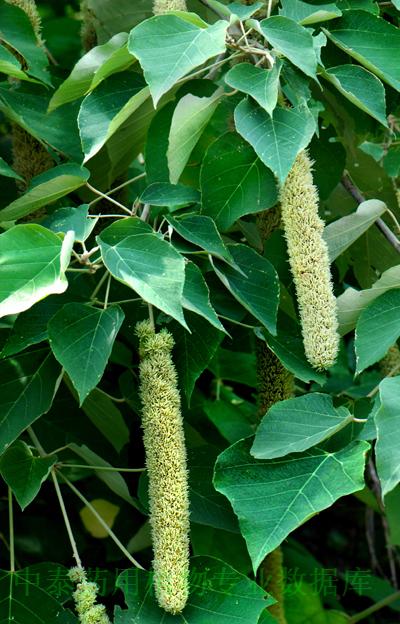| [English Name] | Whiteback leaf, Mallotus Leaf | |
| [Chinese Name] | 白背叶 | |
| [Pinying Name] | Baibeiye | |
| [Latin Name] | Folium Malloti Apeltae | |
| [Genera] | Euphorbiaceae | |
| [Efficacy] | jiedushachongyao | |
| [Pictures] | Plant picture | Drug picture |

|
|
|
| [Alias] | Baiheye, Baimianji, Baimianfeng, Baitaoye, Baimianjian, Baimaoding, Baimoshu, Baipaoshu | |
| [Source] | This crude drug is the leaf of Mallotus apelta (Lour.) Muell.-Arg. (family: Euphorbiaceae). |
|
| [Plant morphology] | This species is a perennial shrub or small-type tree. The branches, petioles and inflorescences are all covered with white or slightly yellow asteroidal fuzzes. The simple leaves are alternate; the blade is broad-ovate, 4.5 |
|
| [Distribution] | This species is distributed in |
|
| [Gathering and processing] | The leaves are gathered in the autumn, and dried in the sun before the inflorescence is removed. |
|
| [Characteristics] | The leaves are simple and alternate, with a long petiole; the blade is ovate, 7-12cm long, 5-14cm wide, tapered apically, approximately truncate at the base where 2 glandular spots are present, entire or irregularly 3-lobed at the margin, nearly hairless on the upper side, gray and densely covered with asteroidal hairs and brown glandular spots on the lower side. This crude drug has a weak smell, and tastes bitter and astringent. |
|
| [Ecology] | It grows in hillside、road side、bushes or forest side. | |
| [Chemical composition] | The leaves contains viceninⅡ[1], chrysophanol, nicotinic acid, isoscopoletin, p-methoxybenzoic acid[2]。 The roots contains, ursolic acid acetate, erythrodiol-3-acetas, β-sitosterol, 2β,29-dihydroxylupane, malloapeltine, mallocerebroside, malloceramide, 4,5,4′-trimethylellagic acid, malloapeltin, daucosterol[3]. |
|
| [Pharmacological activities] |
1 Antibacterial and antiviral effects: The water decoction of Whiteback leaf root has inhibitory effect on Staphylococcus aureus [1]. Root ethanol extract can inhibit Shigella dysenteriae, five compounds isolated from the root have different levels of inhibition on Staphylococcus aureus, Escherichia coli, Bacillus subtilis, Pseudomonas aeruginosa [2]. Applying duck hepatitis B virus (D-HBV) test and real-time quantitative fluorescence techniques (PCR) to detect serum D-HBV DNA content, then perform histopathology histological observation of liver before and after treatment. Results show that serum virus levels of the high, medium dose group of Whiteback leaf have a significant decrease at the 14, 21 days, respectively, after drug withdrawal, the high and middle dose groups of Whiteback leaf root still show a certain degree of virus inhibition. Serum virus levels of Lamivudine group are decreased, but rebound phenomenon appears after drug withdrawal; the high-dose group of Whiteback leaf root has a more obvious improvement on liver inflammation than lamivudine group. Whiteback leaf root can inhibit the replication of D-HBV in vivo, the role can maintain a long time and the drug is safer [3]. The half-toxic concentration (TC50) of Whiteback leaf root on hepatic blastoma cell line HepG2.2.15 in vitro is 48.25mg/ml, the therapeutic index of inhibiting HepG2.2.15 cell secretion of HBsAg and HBeAg are 13.26 and 43.08, it only has weak inhibition on HBV- DNA, suggesting that the Whiteback leaf root has a direct anti-HBV activity on cell culture in vitro [4]. 2 Hepatoprotective and antioxidant effects: The Whiteback leaf root can significantly reduce the levels of serum alanine aminotransferase (ALT), aspartate aminotransferase (AST), malondialdehyde (MDA) and nitric oxide (NO) in 40% CCL4 peanut oil solution induced liver fibrosis rat, and can reduce the degree of hepatic collagen fibers, suggesting that Whiteback leaf root has a good anti-hepatic fibrosis and antioxidant capacity [5]. Whiteback leaf root can significantly reduce elevated NO and MDA levels caused by H2O2 in rat liver cell damage test (2mmol/L), increase SOD activity and reduce the concentration of ALT in the liver cell suspension, showing the Whiteback leaf root has apparent protective effect on oxidative damage induced by H2O2 in rat hepatocytes [6]. 3 Other: Immersing snails in 0.5%~1% of Whiteback leaf decoction or infusion, can inhibit the snails activity [7]. The Whiteback leaf water extracts have inhibitory effects on mouse reverse transcriptase and human III nasopharyngeal carcinoma DNA polymerase, with the IC50 values of 0.5μg/ml and 1.4μg/ml. The extracts can also inhibit E. coli DNA polymerase I and RNA polymerase [8]. |
|
| [Clinical trial] | Clinical reseach: |
|
| [Properties] | ||
| [Medical and other Uses] | ||
| [Dosage] | ||
| [Cautions] | ||
| [Traditional usage] |
1. Suppurative otitis media 2. Traumatic hemorrhage, ulcer 3. Cellulitis 4. Eczema 5. Furuncle and sore festering 6. Cuts hemorrhage 7. Neonatal thrush 8. Postartum convulsion |
|
| [Toxicological studies] | ||
| [Pharmaceutical preparations] | ||
| [References] |
Clinical trials: [1] Yan Ping. The clinical observation of “Malloti Apeltae Folium Drops” in the treatment of chronic tympanitis curative [J]. Chinese New medicine, 1988 (10) : 51. |
|